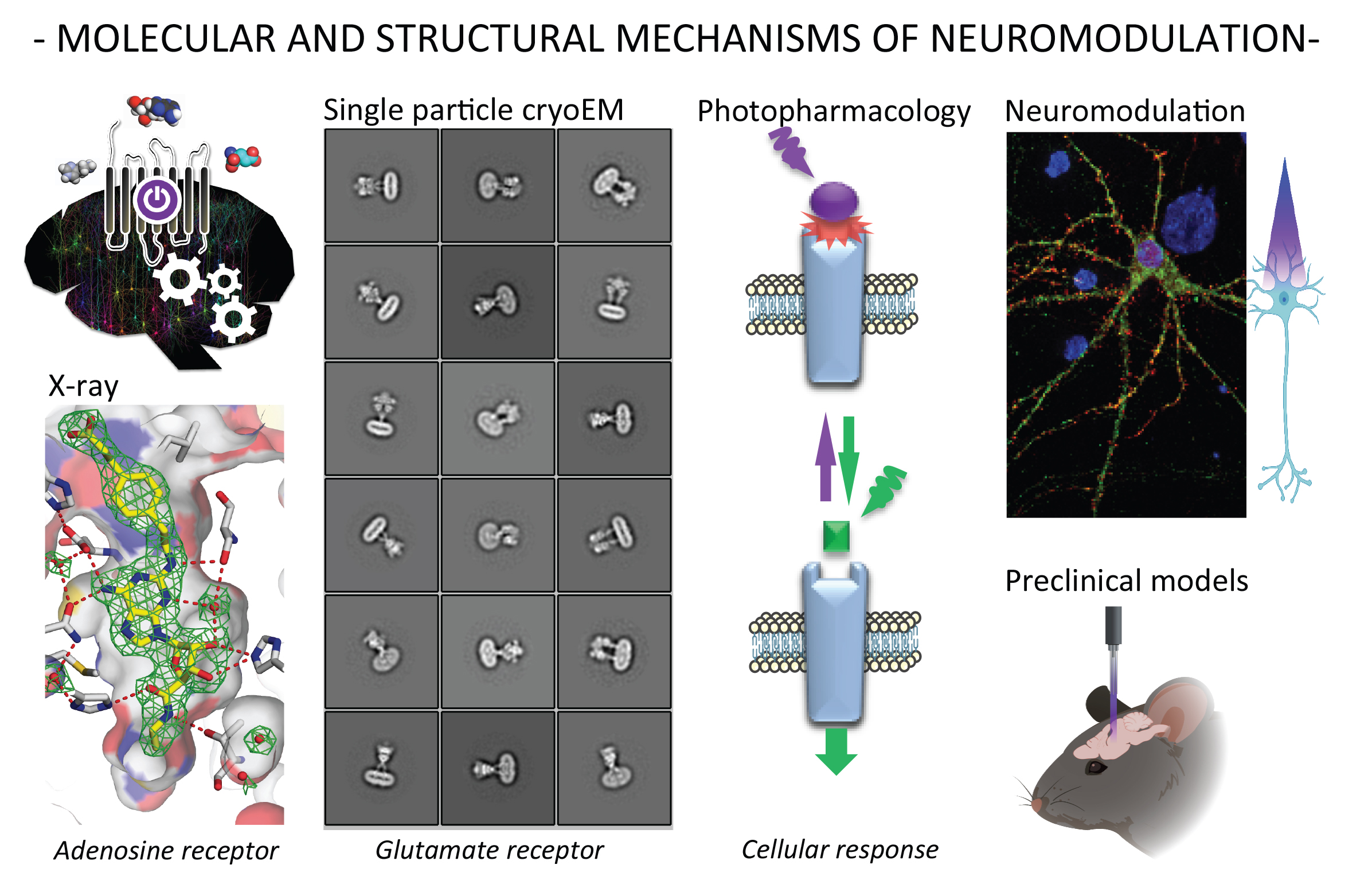MOLECULAR AND STRUCTURAL MECHANISMS OF NEUROMODULATION
Department: Neuroscience
Research subject
In a multiscale approach, we aim to understand neuromodulatory mechanisms of therapeutic interest, from the molecular to the organism level.
Neuromodulation is a slow adaptation of neuronal activity resulting from the action of neuromediators on slow-acting metabotropic receptors, typically, G Protein Coupled Receptors (GPCRs). An imbalance between the excitatory and inhibitory systems is observed in most neurological diseases, due to a dysregulation of neurotransmission and neuromodulation mechanisms. From the therapeutic point of view, GPCRs thus appear as interesting targets to monitor neuronal activity, as shown by the fact that about half of the current marketed drugs are acting directly or indirectly on GPCRs.
Among CNS disorders, we are especially interested in chronic pain and its neuromodulation by two neuromodulators, adenosine and glutamate. Adenosine plays notably an important role in inflammation while glutamate is the main neuromediator involved in pain transmission. Neuromodulatory actions of adenosine and glutamate occur through two families of GPCRs, composed of four and eight subtypes, respectively.
The projects developed in the team are at the interface between the field of chemistry and biology. By combining structural biology (X-ray crystallography and cryo-EM), molecular, cellular and preclinical pharmacology and photopharmacology, our team explore the structure and function of adenosine and glutamate receptors, their signalling complexes and their functional interplay, at the animal, cellular in primary cells, and protein levels.
Keywords:
GPCRs; Adenosine; Glutamate; Pain; Structural biology; Molecular, Cellular and Preclinical Neuropharmacology; Photopharmacology; Pain
Neuromodulation is a slow adaptation of neuronal activity resulting from the action of neuromediators on slow-acting metabotropic receptors, typically, G Protein Coupled Receptors (GPCRs). An imbalance between the excitatory and inhibitory systems is observed in most neurological diseases, due to a dysregulation of neurotransmission and neuromodulation mechanisms. From the therapeutic point of view, GPCRs thus appear as interesting targets to monitor neuronal activity, as shown by the fact that about half of the current marketed drugs are acting directly or indirectly on GPCRs.
Among CNS disorders, we are especially interested in chronic pain and its neuromodulation by two neuromodulators, adenosine and glutamate. Adenosine plays notably an important role in inflammation while glutamate is the main neuromediator involved in pain transmission. Neuromodulatory actions of adenosine and glutamate occur through two families of GPCRs, composed of four and eight subtypes, respectively.
The projects developed in the team are at the interface between the field of chemistry and biology. By combining structural biology (X-ray crystallography and cryo-EM), molecular, cellular and preclinical pharmacology and photopharmacology, our team explore the structure and function of adenosine and glutamate receptors, their signalling complexes and their functional interplay, at the animal, cellular in primary cells, and protein levels.
Keywords:
GPCRs; Adenosine; Glutamate; Pain; Structural biology; Molecular, Cellular and Preclinical Neuropharmacology; Photopharmacology; Pain
Major publications
- Ricart-Ortega M, Berizzi AE, Pereira V, Malhaire F, Catena J, Font J, Gomez-Santacana X, Munoz L, Zussy C, Serra C, Rovira X, Goudet C and Llebaria A (2020) Mechanistic Insights into Light-Driven Allosteric Control of GPCR Biological Activity. ACS Pharmacol Transl Sci 3:883-895.
- Nasrallah C, Rottier K, Marcellin R, Compan V, Font J, Llebaria A, Pin JP, Baneres JL and Lebon G (2018) Direct coupling of detergent purified human mGlu5 receptor to the heterotrimeric G proteins Gq and Gs. Sci Rep 8:4407.
- Zussy C, Gomez-Santacana X, Rovira X, De Bundel D, Ferrazzo S, Bosch D, Asede D, Malhaire F, Acher F, Giraldo J, Valjent E, Ehrlich I, Ferraguti F, Pin JP, Llebaria A and Goudet C (2018) Dynamic modulation of inflammatory pain-related affective and sensory symptoms by optical control of amygdala metabotropic glutamate receptor 4. Mol Psychiatry 23:509-520.
- Lebon G, Edwards PC, Leslie AG and Tate CG (2015) Molecular Determinants of CGS21680 Binding to the Human Adenosine A2A Receptor. Mol Pharmacol 87:907-915.
- Lebon G, Warne T, Edwards PC, Bennett K, Langmead CJ, Leslie AG, Tate CG. Agonist-bound adenosine A2A receptor structures reveal common features of GPCR activation. Nature. 2011; 474(7352):521-5.







